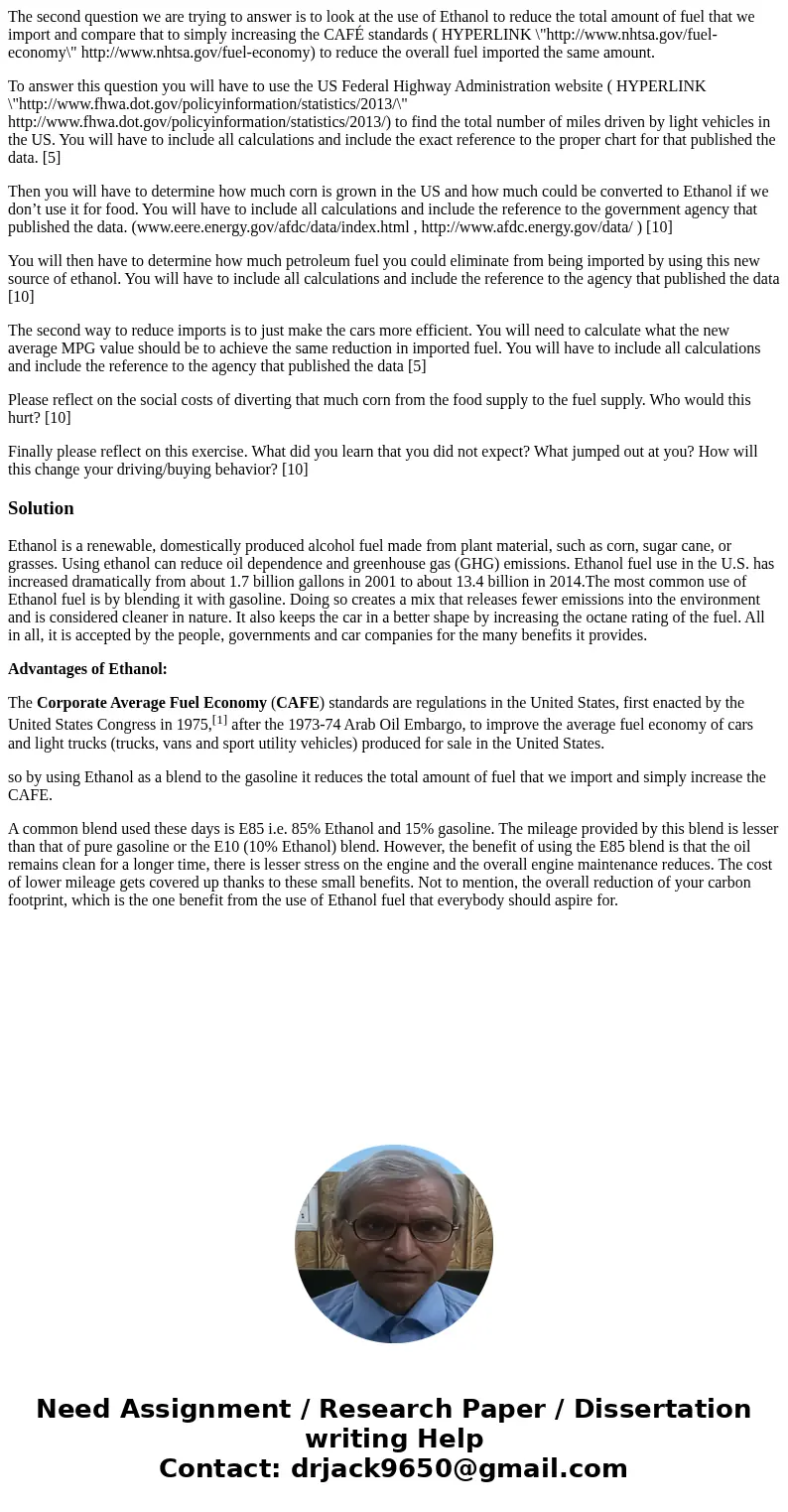The second question we are trying to answer is to look at th
The second question we are trying to answer is to look at the use of Ethanol to reduce the total amount of fuel that we import and compare that to simply increasing the CAFÉ standards ( HYPERLINK \"http://www.nhtsa.gov/fuel-economy\" http://www.nhtsa.gov/fuel-economy) to reduce the overall fuel imported the same amount.
To answer this question you will have to use the US Federal Highway Administration website ( HYPERLINK \"http://www.fhwa.dot.gov/policyinformation/statistics/2013/\" http://www.fhwa.dot.gov/policyinformation/statistics/2013/) to find the total number of miles driven by light vehicles in the US. You will have to include all calculations and include the exact reference to the proper chart for that published the data. [5]
Then you will have to determine how much corn is grown in the US and how much could be converted to Ethanol if we don’t use it for food. You will have to include all calculations and include the reference to the government agency that published the data. (www.eere.energy.gov/afdc/data/index.html , http://www.afdc.energy.gov/data/ ) [10]
You will then have to determine how much petroleum fuel you could eliminate from being imported by using this new source of ethanol. You will have to include all calculations and include the reference to the agency that published the data [10]
The second way to reduce imports is to just make the cars more efficient. You will need to calculate what the new average MPG value should be to achieve the same reduction in imported fuel. You will have to include all calculations and include the reference to the agency that published the data [5]
Please reflect on the social costs of diverting that much corn from the food supply to the fuel supply. Who would this hurt? [10]
Finally please reflect on this exercise. What did you learn that you did not expect? What jumped out at you? How will this change your driving/buying behavior? [10]
Solution
Ethanol is a renewable, domestically produced alcohol fuel made from plant material, such as corn, sugar cane, or grasses. Using ethanol can reduce oil dependence and greenhouse gas (GHG) emissions. Ethanol fuel use in the U.S. has increased dramatically from about 1.7 billion gallons in 2001 to about 13.4 billion in 2014.The most common use of Ethanol fuel is by blending it with gasoline. Doing so creates a mix that releases fewer emissions into the environment and is considered cleaner in nature. It also keeps the car in a better shape by increasing the octane rating of the fuel. All in all, it is accepted by the people, governments and car companies for the many benefits it provides.
Advantages of Ethanol:
The Corporate Average Fuel Economy (CAFE) standards are regulations in the United States, first enacted by the United States Congress in 1975,[1] after the 1973-74 Arab Oil Embargo, to improve the average fuel economy of cars and light trucks (trucks, vans and sport utility vehicles) produced for sale in the United States.
so by using Ethanol as a blend to the gasoline it reduces the total amount of fuel that we import and simply increase the CAFE.
A common blend used these days is E85 i.e. 85% Ethanol and 15% gasoline. The mileage provided by this blend is lesser than that of pure gasoline or the E10 (10% Ethanol) blend. However, the benefit of using the E85 blend is that the oil remains clean for a longer time, there is lesser stress on the engine and the overall engine maintenance reduces. The cost of lower mileage gets covered up thanks to these small benefits. Not to mention, the overall reduction of your carbon footprint, which is the one benefit from the use of Ethanol fuel that everybody should aspire for.

 Homework Sourse
Homework Sourse